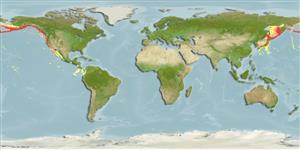>
Perciformes/Scorpaenoidei (Scorpionfishes) >
Sebastidae (Rockfishes, rockcods and thornyheads) > Sebastolobinae
Etymology: Sebastolobus: Greek, sebastes = august, venerable + Greek, lobos = lobe (Ref. 45335); alascanus: Species name after Alaska, the type locality (Ref. 27436).
More on author: Bean.
Environment: milieu / climate zone / depth range / distribution range
Ecologie
marien demersaal; diepte 17 - 1600 m (Ref. 50550), usually 91 - ? m (Ref. 2850). Temperate
North Pacific: Sea of Okhotsk north to the Navarin Canyon in the Bering Sea and from Stalemate Bank and Ulm Plateau in the Aleutian Islands southeast to Cedros Island, Baja California, Mexico. Reported from Japan (Ref. 559).
Lengte bij maturiteit / Grootte / Gewicht / Leeftijd
Maturity: Lm 22.0 range ? - ? cm
Max length : 80.0 cm SL mannelijk / geslacht onbekend; (Ref. 559); max. gepubliceerd gewicht: 9.0 kg (Ref. 56527); max. gerapporteerde leeftijd: 100 Jaren (Ref. 90032)
Dorsale stekels (totaal): 15 - 17; Dorsale zachte stralen (totaal): 8-9; Anale stekels 3; Anale zachte stralen: 4 - 5. Head spines very strong - nasal, preocular, supraocular, postocular, tympanic, parietal and nuchal spines present, coronal spines absent; large head and elongate body; strong spiny ridge on head; 3rd dorsal spine not much longer than 2nd, 4th or 5th; strong notch on pectoral fin (Ref. 27437). Bright red with some black on fins; gill chamber mostly pale (Ref. 27437). Caudal slightly rounded (Ref. 6885).
Very common on soft bottoms (Ref. 2850). Oviparous (Ref. 205). Eggs are extruded in floating gelatinous masses (Ref. 31279). Have a thick glandular tissue on posterior margin of fin spines which is believed to be venomous (Ref. 57406). Rarely taken by game fishers (Ref. 27436). Flesh sweeter than that of other rockfishes (Ref. 27436).
Unlike other representatives of this group, this species has internal fertilization Oviparous (Ref. 6885). Females possess specialized ovarian structures including stalk-like ovigerous lamellae and secretory epithelia (Ref. 32832).
Eschmeyer, W.N., E.S. Herald and H. Hammann, 1983. A field guide to Pacific coast fishes of North America. Boston (MA, USA): Houghton Mifflin Company. xii+336 p. (Ref. 2850)
Status op de Rode Lijst van het IUCN (Ref. 130435)
Gebruik door de mens
Visserij: van minder commercieel belang
Meer informatie
ReferentiesAquacultuurAquacultuurprofielKweeklijnenGeneticaElectrophoresesErfelijkheidZiektesVerwerkingNutrientsMassaconversie
Tools
Speciale rapporten
Download XML
Internetbronnen
Estimates based on models
Preferred temperature (Ref.
123201): 1.2 - 6.7, mean 3.8 °C (based on 417 cells).
Fylogenetische diversiteitsindex (Ref.
82804): PD
50 = 0.6250 [Uniqueness, from 0.5 = low to 2.0 = high].
Bayesian length-weight: a=0.00708 (0.00408 - 0.01228), b=3.16 (3.00 - 3.32), in cm total length, based on LWR estimates for this species & (Sub)family-body (Ref.
93245).
Trofisch niveau (Ref.
69278): 3.6 ±0.3 se; based on diet studies.
Generation time: 47.8 ( na - na) years. Estimated as median ln(3)/K based on 1
growth studies.
Weerstandsvermogen (Ref.
120179): Zeer laag, minimale populatieverdubbelingstijd meer dan 14 jaar (tmax> 100 (validated age: 62 yrs); tm= 13; Fec > 10,000).
Prior r = 0.02, 95% CL = 0.01 - 0.03, Based on 1 stock assessment.
Fishing Vulnerability (Ref.
59153): High vulnerability (59 of 100).
Climate Vulnerability (Ref.
125649): Moderate vulnerability (38 of 100).
Nutrients (Ref.
124155): Calcium = 18.4 [8.0, 49.9] mg/100g; Iron = 0.287 [0.128, 0.565] mg/100g; Protein = 17.5 [15.8, 19.3] %; Omega3 = 1.01 [0.41, 2.73] g/100g; Selenium = 29.6 [13.0, 73.1] μg/100g; VitaminA = 13.5 [3.9, 44.9] μg/100g; Zinc = 0.518 [0.305, 0.810] mg/100g (wet weight);
